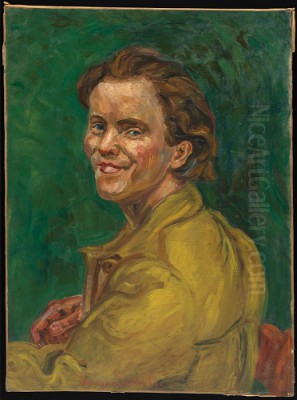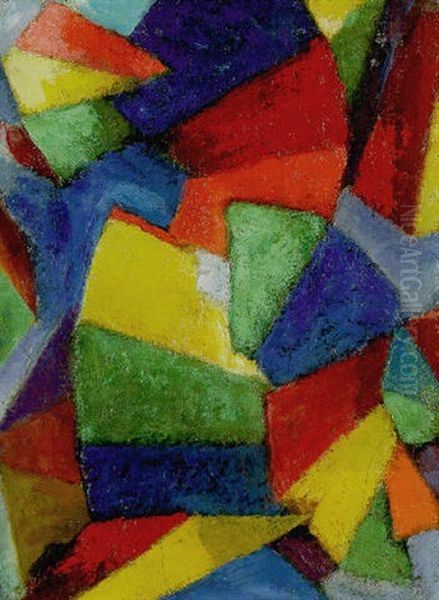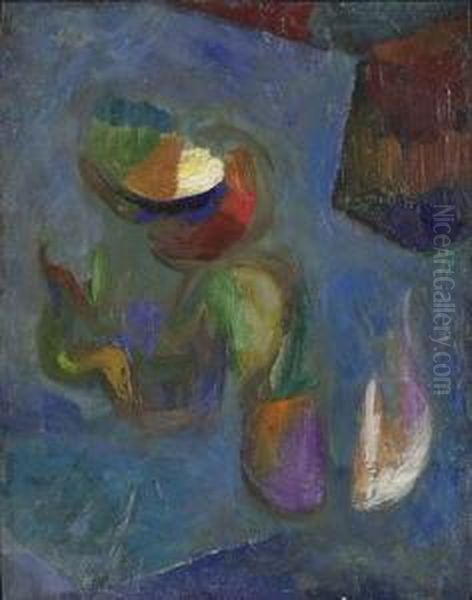
Morgan Russell stands as a pivotal figure in the narrative of American modernism, an artist whose explorations into the very essence of color fundamentally altered the course of abstract art in the early 20th century. Alongside his compatriot Stanton MacDonald-Wright, Russell co-founded Synchromism, one of the first American avant-garde movements to gain international attention. His life journey, marked by early tragedy, European immersion, groundbreaking innovation, and later shifts in focus, offers a compelling look into the forces that shaped modern art. This exploration delves into Russell's biography, his revolutionary artistic theories, his key works, his relationships within the art world, and his enduring legacy.
Early Life and Formative Influences
Born in New York City in 1886, Morgan Russell's early life was touched by instability. His father, Charles Russell, an architect, passed away when Morgan was just nine. His mother, Adolt Russell, remarried but also died not long after, leaving the young Russell without immediate family support during his formative years. This challenging start perhaps instilled in him a resilience and an independent spirit that would later characterize his artistic pursuits.
Despite these hardships, Russell's artistic inclinations emerged early. He initially pursued architecture, perhaps influenced by his father's profession, but soon shifted his focus entirely to fine art. He enrolled at the Art Students League, a crucial hub for aspiring artists in New York, where he began honing his skills. A significant turning point came through the patronage of Gertrude Vanderbilt Whitney, a prominent sculptor and art collector who would later found the Whitney Museum of American Art. Her financial support was instrumental, enabling Russell to pursue his artistic education more seriously.

In 1906, Whitney's backing facilitated Russell's first transformative trip to Europe. He traveled through France and Italy, immersing himself in the masterpieces of the past. He was particularly captivated by the power and dynamism of Renaissance masters like Michelangelo, whose sculptural understanding of form left an indelible mark on him. He also studied the works of Mannerist painters like Bronzino and early Renaissance pioneers like Giotto, absorbing lessons in composition, color, and emotional expression. This direct encounter with the European tradition provided a vital foundation upon which his later modernist innovations would be built.
Paris, Matisse, and the Seeds of Synchromism
Returning briefly to the United States, Russell continued his studies, but the lure of Europe, particularly Paris – the undisputed center of the art world at the time – proved irresistible. He moved to Paris around 1909, a city teeming with artistic experimentation. This move placed him directly in the crucible of modernism. He sought out instruction from Henri Matisse, one of the leading figures of Fauvism, known for his radical use of non-naturalistic color and bold compositions. Studying under Matisse, even briefly, exposed Russell to the expressive potential of color freed from purely descriptive duties.
Paris also brought him into contact with the burgeoning Cubist movement, spearheaded by Pablo Picasso and Georges Braque. While not a Cubist himself, Russell absorbed the lessons of their fragmented forms and multiple viewpoints, understanding how they challenged traditional representation. Equally important was the pervasive influence of Paul Cézanne, whose structured compositions and use of color modulation to build form resonated deeply with Russell's developing ideas.
Crucially, it was in Paris that Russell met fellow American artist Stanton MacDonald-Wright around 1911. They shared a deep interest in color theory and a desire to push painting beyond the boundaries established by Impressionism and Cubism. Both artists studied the color theories of earlier scientists and artists, but they were particularly influenced by the teachings of Canadian painter Percyval Tudor-Hart, who lectured in Paris on the relationship between color and music, proposing systems of color harmony analogous to musical scales and chords. This concept became central to their artistic quest.
The Birth of Synchromism
Fueled by shared ideas and mutual ambition, Russell and MacDonald-Wright began collaborating intensely, developing a new approach to painting they christened "Synchromism." The name, derived from Greek roots meaning "with color," deliberately echoed "symphony," highlighting their core belief that color could be orchestrated like musical notes to create harmonies and rhythms that constituted the painting's primary structure and emotional content.

Synchromism's fundamental principle was that form should be generated through color, not defined by line. They believed colors had inherent spatial properties – warm colors like reds and oranges tending to advance, cool colors like blues and violets tending to recede. By juxtaposing and modulating these colors according to theoretical principles of harmony and contrast, they aimed to create abstract compositions possessing depth, volume, and dynamic rhythm purely through chromatic relationships. It was an art form intended to appeal directly to the senses, much like music, bypassing literal representation to evoke feeling and structure.
The public debut of Synchromism occurred in 1913, a landmark year for modern art. Russell and MacDonald-Wright held exhibitions first at the Galerie Bernheim-Jeune in Paris in June, and later that year in Munich. These shows featured abstract works composed of swirling, intersecting planes of vibrant color. They issued manifestos proclaiming their theories, asserting color's primacy and its capacity to be the sole means of artistic expression. Their work immediately drew comparisons to Orphism, the contemporary color-based abstract movement led by Robert Delaunay and Sonia Delaunay in Paris. While there were visual similarities and shared roots in Cubism and color theory, Russell and MacDonald-Wright were adamant about Synchromism's distinctness, emphasizing their more "sculptural" approach to form built through color, perhaps reflecting Russell's deep admiration for Michelangelo.
Key Synchromist Works and Exhibitions
Morgan Russell's paintings from the peak Synchromist period (roughly 1912-1916) are characterized by their dynamic energy and sophisticated color orchestration. One of his most celebrated works is Synchromy in Green (c. 1913). This painting exemplifies the movement's goals, featuring interlocking shards and curves of greens, blues, yellows, and reds that seem to push and pull, creating a sense of volumetric form and rhythmic movement entirely through color interactions. The composition avoids any recognizable subject matter, focusing instead on the pure visual impact of chromatic harmony and dissonance.
Another crucial work is Synchromy in Orange: To Form (1913-1914). Here, Russell employs a warmer palette dominated by oranges, reds, and yellows, contrasted with blues and violets. The title itself underscores the Synchromist aim: to achieve form through color. The arrangement of color planes suggests muscular, dynamic shapes, perhaps abstracting the human figure in motion, harking back to his studies of Michelangelo. The interplay of advancing warm colors and receding cool colors creates a powerful sense of spatial depth and tension within the abstract composition.
Russell also explored cooler palettes, as seen in works like Creavit Deus Hominem (Synchromy) (1914). These paintings demonstrate the versatility of the Synchromist approach, capable of evoking different moods and structural sensations depending on the chosen color harmonies. The works often feature complex, almost baroque arrangements of color shapes, suggesting a deep engagement with both Renaissance structure and modern abstraction.
Following the European debuts, Synchromism was introduced to the United States with a significant exhibition at the Carroll Galleries in New York City in March 1914. This show brought the radical ideas of Russell and MacDonald-Wright directly to an American audience, contributing significantly to the dialogue around modern art that had been ignited by the Armory Show the previous year. It positioned Synchromism as America's first homegrown avant-garde movement to make a mark on the international stage.
The Synchromist Circle and Critical Reception
While Russell and MacDonald-Wright were the primary theorists and practitioners of Synchromism, their ideas attracted other artists. Patrick Henry Bruce, another American painter in Paris, was closely associated with Synchromism for a period, creating powerful abstract compositions based on color principles, though he later developed his own distinct style. Andrew Dasburg, who had also spent time in Paris, experimented with Synchromist ideas upon his return to the US. Even Thomas Hart Benton, later known for his Regionalist murals, briefly explored Synchromist color abstraction in his early career after encountering Russell and MacDonald-Wright's work.
The critical reception of Synchromism was mixed but significant. In Paris, critics debated its relationship to Orphism, sometimes accusing Russell and MacDonald-Wright of being derivative, a charge they vehemently denied. They engaged in public debates and published further texts to clarify their theories and assert their originality. In the United States, the 1914 Carroll Galleries show generated considerable discussion, positioning Synchromism as a bold, if controversial, contribution to modern art. It challenged American artists and audiences to engage with abstraction and advanced color theory.
Despite the initial burst of activity and attention, Synchromism as a cohesive movement was relatively short-lived, largely dissolving with the outbreak of World War I, which disrupted the international art scene and prompted many American artists, including Russell and MacDonald-Wright, to eventually return to the United States. However, its impact resonated beyond its active years.
Evolution Beyond Pure Synchromism
After the initial intensity of the Synchromist period, Morgan Russell's art began to evolve. While color remained central to his practice, he started to move away from complete abstraction. The influence of Cézanne and his enduring admiration for the structure of Old Masters like Michelangelo led him towards works that integrated abstract color principles with more recognizable forms, particularly the human figure.
During the later 1910s and 1920s, Russell spent considerable time studying sculpture, particularly the works of Michelangelo. This resulted in drawings and paintings where powerful, muscular figures are rendered using the dynamic color contrasts and rhythmic structures developed during his Synchromist phase. These works represent a synthesis of his interests – the volumetric power of Renaissance sculpture translated through the lens of modern color theory.
Around 1922, Russell revisited his earlier abstract principles in a series known as Eidos, a Greek term referring to form or essence. These works were perhaps an attempt to codify or reflect upon his Synchromist explorations, creating structured, philosophical compositions based on color-form relationships. However, his general trajectory during the interwar period leaned more towards representational subjects, including still lifes, landscapes, and figurative works, though always informed by his sophisticated understanding of color.
This shift did not necessarily represent a rejection of his earlier innovations but rather an integration of them into a broader artistic practice. He continued to believe in the fundamental importance of color, but his application of these principles became more varied, adapting to different subjects and expressive needs.
Later Life, Renewed Collaborations, and Final Years
Russell returned to the United States permanently in the 1930s. For a time, in 1931, he lived in California, where he reconnected with Stanton MacDonald-Wright. The two artists collaborated again, exploring abstract possibilities, though the context was now different, informed by the artistic developments that had occurred since their initial Synchromist breakthroughs. While some accounts mention an exploration of "abstract expressionism," this term is likely used loosely, as the movement known by that name emerged later, after World War II. It's more probable they were engaging with ongoing trends in abstraction, perhaps influenced by Surrealism or biomorphic forms, while revisiting their shared history.
Russell eventually settled in southeastern Pennsylvania. His life took another significant turn in 1947 when he converted to Catholicism. This spiritual shift reportedly had a profound impact on his outlook and, according to some sources, influenced his artistic activities, possibly leading him to focus more on religious themes or even dedicate more time to writing alongside painting. It's unlikely he completely abandoned visual art, but his focus may have shifted.
His later years were marked by declining health. In 1950, Russell suffered a stroke, which impaired his ability to work and required him to painstakingly relearn basic skills. Despite these challenges, he continued to engage with art as much as his health allowed. Morgan Russell passed away in 1953 at a nursing home in Broomall, near Philadelphia, Pennsylvania, at the age of 67.
Throughout his career, Russell maintained complex relationships within the art world. His collaboration with MacDonald-Wright was foundational but also subject to tensions, with Russell sometimes feeling that his partner was less radical or fully committed to the purest implications of their theories. His early patronage by Gertrude Vanderbilt Whitney was crucial, linking him to an important network in American art. His time in Paris placed him within the orbit of figures like Gertrude Stein, whose salon was a meeting place for the avant-garde, including Picasso and Matisse. While Synchromism competed for attention with Orphism (Robert and Sonia Delaunay), Russell's primary focus seemed to be on developing his own theories rather than direct rivalry. Compared to the circle around Alfred Stieglitz in New York (which included Georgia O'Keeffe, Arthur Dove, and Marsden Hartley), Russell and MacDonald-Wright represented a different, European-based trajectory for early American modernism.
Anecdotes also suggest Russell harbored some frustration with the commercial aspects of the art world, feeling that dealers held too much sway over artists' careers – a sentiment not uncommon among avant-garde artists challenging the status quo.
Academic Assessment and Enduring Legacy
In the decades following his death, Morgan Russell's contributions have been increasingly recognized by art historians. While Synchromism itself was a relatively brief movement, its significance lies in its pioneering role in American abstract art and its sophisticated engagement with color theory. Russell and MacDonald-Wright were among the very first American artists to develop and exhibit a fully abstract style, doing so on an international stage.
Academic assessment highlights Russell's unique synthesis of influences – the structural power of Michelangelo, the color modulation of Cézanne, the expressive freedom of Matisse, and the theoretical rigor derived from thinkers like Tudor-Hart. His work is praised for its intellectual depth and its visual dynamism. Paintings like Synchromy in Green and Synchromy in Orange: To Form are now considered key works of early American modernism, demonstrating a bold and original approach to non-representational art.
Scholars acknowledge the importance of Synchromism in challenging American art to move beyond realism and Impressionism. Although its direct influence was perhaps less widespread than that of Cubism, its emphasis on color as a primary structural and expressive element foreshadowed later developments in color field painting and other abstract movements. Russell's insistence on the connection between color and music, and his attempts to create a "sculptural" form through purely chromatic means, represent a significant theoretical contribution.
Today, Morgan Russell is firmly established as a major figure in American art history. His works are held in major museum collections, including the Museum of Modern Art in New York, the Whitney Museum of American Art, and the Los Angeles County Museum of Art. Exhibitions and scholarly publications continue to explore the nuances of his career, from the groundbreaking Synchromist experiments to his later figurative work, recognizing the consistent thread of profound engagement with color and form that runs through his entire oeuvre. He remains a testament to the spirit of innovation that characterized the early modernist era.
Conclusion
Morgan Russell's artistic journey was one of bold exploration and intellectual rigor. From his early immersion in European art history to his co-creation of Synchromism, he consistently pushed the boundaries of painting. His fundamental insight – that color itself could be the primary means of constructing form, space, and emotion – placed him at the forefront of abstract art. Though Synchromism as a movement was fleeting, Russell's work within it, and his lifelong dedication to understanding the power of color, secured his place as a crucial pioneer of American modernism. His legacy lies not only in his vibrant canvases but also in his contribution to the very language of modern art.